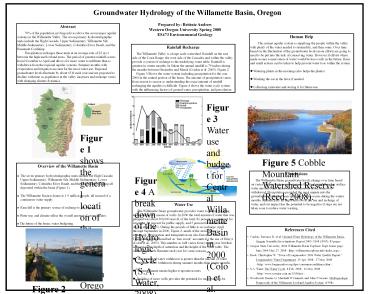Abstract - PowerPoint PPT Presentation
1 / 1
Title:
Abstract
Description:
... greatest rainfall occurs from November to April and allows for more water to ... During the periods of little to no recharge, April through September in 2000, ... – PowerPoint PPT presentation
Number of Views:115
Avg rating:3.0/5.0
Title: Abstract
1
Groundwater Hydrology of the Willamette Basin,
Oregon
Prepared by Brittnie Andrew Western Oregon
University Spring 2008 ES473 Environmental Geology
Abstract 70 of the population in Oregon lives
above the seven major aquifer systems in the
Willamette Valley. The seven primary
hydrostratigraphic units include the High
Cascade, Upper Sedimentary, Willamette Silt,
Middle Sedimentary, Lower Sedimentary, Columbia
River Basalt, and the Basement Confining.
Precipitation recharges these units at an
average rate of 22 in/yr between the high and
lowland areas. The period of greatest rainfall
occurs from November to April and allows for more
water to infiltrate than is withdrawn from the
regional aquifer systems. Summer months with
evaporation and irrigation account for the most
water use. Regional groundwater levels fluctuate
by about 65 ft each year and are projected to
decline with time as population in the valley
increases and recharge varies with changing
climate dynamics.
- Human Help
- The current aquifer system is supplying the
people within the valley with plenty of the water
needed to sustain life, and then some. Over time
based on the fluctuation of the groundwater
levels more efforts are going to need to be put
into the task of conserving water. However if
efforts where made sooner conservation of water
would be less costly in the future. Basic and
small actions can be taken to help prevent water
lose within the system. - Watering plants in the morning (also helps the
plants). - Washing the car in the lawn if needed.
- Collecting rainwater and storing it for future
use.
- Rainfall Recharge
- The Willamette Valley is a large scale
watershed. Rainfall on the east side of the Coast
Range, the west side of the Cascades and within
the valley provide a system of recharge to the
underlying water table. Rainfall is greatest in
winter months. In Salem the annual rainfall is 79
inches during the months between December and
March (Conlon et al. 2005). Figure 2 - Figure 3 Shows the water system including
precipitation for the year 2000 in the central
portion of the basin. The amount of precipitation
varies from season to season so understanding the
exact amount of rainfall recharging the aquifers
is difficult. Figure 4 shows the water cycle
system with the influencing factors of ground
water, precipitation, and percolation.
Figure 3 Water use and budget for Central
Willamette Basin in 2000 (Colon et al. 2005).
Figure 1 shows the general location of the
Willamette value within Oregon as well as sub
basins (OSU, 2008).
- Overview of the Willamette Basin
- The seven primary hydrostratigraphic units
include the High Cascade, Upper Sedimentary,
Willamette Silt, Middle Sedimentary, Lower
Sedimentary, Columbia River Basalt, and the
Basement Confining all deposited within the
basin (Figure 1). - The Willamette Basin is home to 1.9 million
people, all in need of a continuous water
supply. - Rain fall is the primary source of recharge to
the system. - Water use, and climate effect the overall amount
of ground water. - The future of the basin, water budgeting.
Figure 4 A break down of the Hydrologic Cycle
(S.A. Water, 2008).
- Water Use
- The Willamette Basin groundwater provides water
to people, farming, and industries by means of
wells. In 2000 the total amount of water that was
pumped was about 300,000 acre-ft, of the total,
81 percent was pumped for irrigation, 14 percent
for public supply, and 5 percent for industrial
use (Colon et al., 2005). During the periods of
little to no recharge, April through September in
2000, Figure 2, much of the stored water is
consumed. Evaporation and transpiration are also
factors in water use. Transpiration, best
described as tree sweat accounts for the use of
28in/yr (Colon et al., 2005). This number as well
varies from year to year, but that is based on
the depth of saturation and the height of the
water table. The water table levels fluctuate
each year for varies reasons. - The amount of water withdrawn is greater than
the amount of water imputed. More withdrawn
during summer months then winter months. - Warmer climate means higher evaporation rates.
- Building of more wells provides the potential
for more water to be used.
- References Cited
- Conlon, Terrence D, et al. Ground-Water
Hydrology of the Willamette Basin, Oregon
Scientific Investigations Report 20055168
(2005). 83 pages - Oregon State University, 2004 Willamette Basin
Explorer. Dept. home page. June 2004 May 27,
2008 .
- Reed, Christopher W. Town of Longmeadow 2006
Water Quality Report. Longmeadow Water
Department. 15 Apr. 2008. 27 May 2008
ce.htm. - S.A. Water. The Water Cycle. 8 Feb. 2008. 26
May 2008 . - Woodward, Dennis G, Marshall W Gannett, and
John J Vaccaro. Hydrogeologic Framework of the
Willamette Lowland Aquifer System (1998).
Figure 2 Willamette River Portland Area (OSU,
2008).































